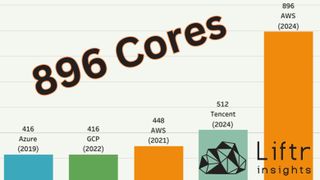Amazon Web Services introduces record 896-core instance — prices range from $150 to $400 per hour
Outside AWS, the closest competing service providers can only offer up to 512 cores

In a release given to PR Newswire, Liftr Insights has identified the existence of an 896-core Amazon Web Services cloud provider instance, which substantially dwarfs the highest core counts available with Tencent and Microsoft Azure service plans. Using this much of AWS' computing power will cost a pretty penny, of course— an estimated range of $150 per hour to around $400 per hour depending on configuration and city— but considering the scale at which modern tech enterprises operate, this actually still seems viable.
As noted by CEO of Liftr Insights Tab Schadt in the original release, "It is not advantageous for AWS to deploy solutions that won't sell, especially at these price points. They spend significant time and money on market intelligence. Other companies can benefit from research about what they are offering and where they offer them at a fraction of the cost."
This 896-core AWS instance has appeared not only on the East and West Coasts of the United States but has also emerged overseas in Seoul, South Korea, and Sydney, Australia. Considering how prominent these areas are in the geopolitical game of chipmaking and the tech industry in general, this makes sense— and it points toward particularly high overseas demand for all the raw cloud compute Amazon is willing to sell.
Tab Schadt additionally speculates that "Perhaps we'll see larger instances in the near future, showing even more demand for high-performance workloads. At the least, we'll keep an eye out to see if and when Azure or other cloud providers respond in kind."
Historically speaking, it shouldn't really surprise anybody to see AWS continue to dominate the cloud computing sphere to this extent. AWS has been in operation since 2002 and has been providing on-demand services to a significant portion of the Internet for most of that time. Services known to rely on AWS include Airbnb and Netflix, and back in 2022, AWS was already serving 1.45 million businesses.
Of course, Tencent and Microsoft are hardly two competitors you can sneeze at. So, Tab Schadt's forecast that competitors like them may soon up their own cloud service provider offerings doesn't seem entirely impossible. But compared to the incumbent AWS, will services like Microsoft Azure really be able to justify the cost of offering 896-core cloud instances?
Stay On the Cutting Edge: Get the Tom's Hardware Newsletter
Get Tom's Hardware's best news and in-depth reviews, straight to your inbox.

Christopher Harper has been a successful freelance tech writer specializing in PC hardware and gaming since 2015, and ghostwrote for various B2B clients in High School before that. Outside of work, Christopher is best known to friends and rivals as an active competitive player in various eSports (particularly fighting games and arena shooters) and a purveyor of music ranging from Jimi Hendrix to Killer Mike to the Sonic Adventure 2 soundtrack.
-
PEnns Can those be used for crypto mining??Reply
If yes, I can imagine some crypto junkies hacking and remotely controlling those....:( -
HaninTH Reply
You don't think they have performance monitoring and other sniffers looking for exactly this kind of thing at this scale? Shirley they have systems in place to limit things because of the power usage needed with that many cores and the impact it would impose on the clusters and only open it up when a paying customer signs up and gets allocated.PEnns said:Can those be used for crypto mining??
If yes, I can imagine some crypto junkies hacking and remotely controlling those....:(
But who knows, maybe it's like Dell in the early-mid 2000s. -
bit_user I'm disappointed the article didn't say what kind of CPU it is, but I'll chip in my best guess: 8-CPU, 56-core Intel Sapphire Rapids (or Emerald Rapids). Also, they're probably counting vCPUs, which gives you 2 per physical core (if hyperthreading is enabled).Reply
Presently, the highest AMD can go is 512 vCPUs, because their highest core-count CPU is 128 cores and they only offer dual-socket scalability. However, the Zen 5C EPYC should go up to 768 threads. -
Replybit_user said:I'm disappointed the article didn't say what kind of CPU it is, but I'll chip in my best guess: 8-CPU, 56-core Intel Sapphire Rapids (or Emerald Rapids). Also, they're probably counting vCPUs, which gives you 2 per physical core (if hyperthreading is enabled).
You are actually correct ! These are indeed Intel Sapphire Rapids vCPUs rather than actual cores. So we are looking at an 8-Socket 56 cores Sapphires Rapids server platform. They are not using Emerald Rapids here.
AWS, like other CSPs, counts a Sapphire Rapids core twice due to SMT. And AMD doesn't give much preference to platform above 2 Sockets. -
oldcomputerguy What kind of BS graph is that, the AWS bar is more then double the next bar but it's not more than double in value.. that's some biased reporting to make AWS look even "better"Reply -
wbfox We've all been there, it's that time of year when the 400 on-prem cores you have just don't cut it, and you need some help doing that heavy lifting for another 1.5 hours, and that is where Liftr comes in! We just think there is a great need out there for costumers, who on occasion, have the need for 896 cores for a few hours before it stops making sense to just buy their own gear. Something about peak web traffic hours and that this cannot be accessed from certain countries but that VPNs and 3rd parties won't be inquired into and that should be good for the bosses back home. Because Amazon shopping is just far too dependent upon good old Ali to be believed.Reply